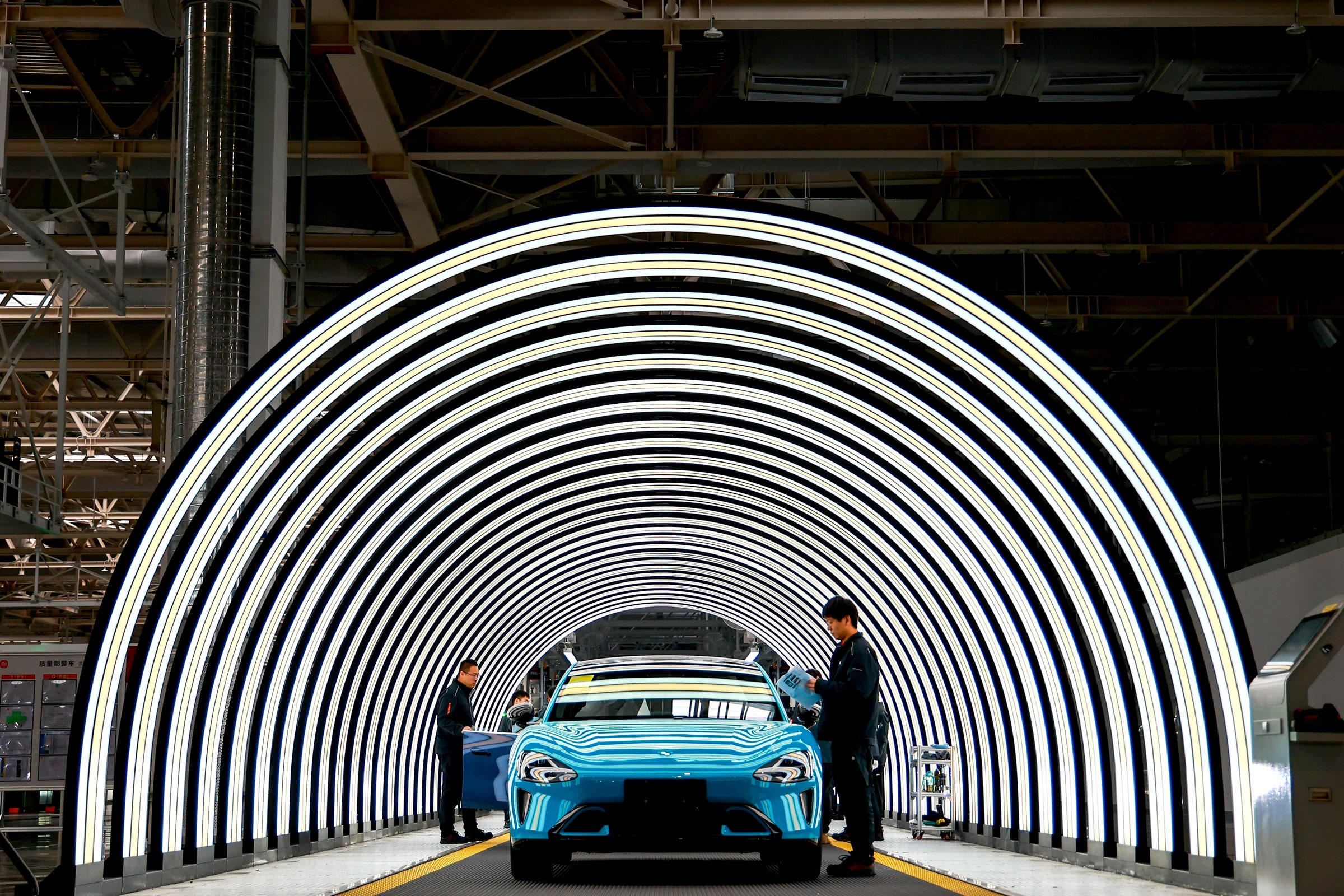Tours of electric vehicle factories have quickly become the hottest ticket in Beijing, with tens of thousands of people signing up each month for the chance to win a free visit. Chinese smartphone giant Xiaomi, which has reinvented itself as an EV maker in recent years, started offering the one-hour tours in January to visitors interested in seeing its factory up close and getting a race car experience in a Xiaomi EV.
As Chinese EV brands expand from competing on low prices to promoting premium features and sleek designs, they are increasingly putting their factories in the spotlight. At least two Chinese EV brands, Xiaomi and Nio, offer regular tours for the general public this year, and three more automakers have announced plans to follow suit.
“More and more Chinese EVs are using factory tours as an important channel of communication between the brand and the outside world. It offers a chance to not only see the production line up close, but also experience the human side of the brand,” says Freya Zhang, a research analyst at the investment consulting firm Tech Buzz China, who has been organizing tours for foreign investors to visit Chinese electric vehicle startups for two years.
People who have visited the Xiaomi factory say they were struck by the amount of automation on display. The company says that the overall automation rate at the factory has reached 91 percent, with some production lines like casting fully automated.
“The factory is huge with only a handful of workers. As I stood there watching, it was all robotic arms doing the work. The robots were all running pre-set programs—picking up parts from one place and delivering them to another, all in a very orderly manner,” says Yuanyuan, a Beijing resident who took her 13-year-old daughter on the Xiaomi tour last month. Yuanyuan says she had been applying to get tickets since January, but since the limited spots are awarded on a lottery basis, she was only finally able to secure them in May.
The EV factory tour trend is not entirely new: Chinese companies have long opened their manufacturing plants to potential investors, entrepreneurs, and groups of young students, but they haven’t become a universal tourist attraction until now. Like Coca Cola, Ben & Jerry’s, and other household names in the West, some Chinese EV brands have become so popular that the idea of getting a behind-the-scenes look has become exciting to a wide range of Chinese consumers. Many of the tourists aren’t even potential carbuyers but are just there to marvel at the industrial robots as a weekend activity.
Zhao Mingfei, a Beijing resident, says he first learned about Xiaomi’s tours by watching livestream broadcasts by the company’s founder, Lei Jun, whose charismatic personality and annual motivational speeches have turned him into a celebrity in China. Zhao says he has long admired the CEO and owns a number of Xiaomi consumer gadgets. He tried to sign up for a tour in January immediately after registration opened, but didn’t get a spot. In February, however, he was one of 60 lucky people selected from more than 7,000 applicants, according to a screenshot he shared with WIRED of the reservation system.
Xiaomi released its first EV model, the SU7, in early 2024. By the end of the year, foreign diplomats, investors, and guests from other Chinese companies had already started arriving at the company’s factory in Beijing to participate in one-off tours, but the company didn’t create a standardized experience for the public until the start of 2025. At first, Xiaomi offered just three tours with 20 participants each per month.
But the excursion proved incredibly popular, and Xiaomi quickly began scheduling significantly more slots. In July, the company said it will offer one tour every weekday and six tours most weekends, accommodating more than 1,100 visitors in total. When July registration opened, however, over 27,000 applications flooded in overnight, according to the Xiaomi app—so the chances of snagging a ticket remain slim.
Those lucky enough to secure a spot can expect to first be taken to an exhibit hall to learn about notable innovations in Xiaomi’s electric cars. The visitors then hop on a shuttle and go into three working production lines out of six total to observe the workers and robots in action.
Afterwards, they can test ride a model Xiaomi SU7 on a racecourse, where a trained racecar driver demonstrates how the car can accelerate from 0 to 60 mph in just a few seconds. “It felt awesome—takes off really fast, with an instant kick,” Zhao tells WIRED. Recently, Xiaomi also started selling affordable meals at the factory and souvenirs to complete the experience.
Another visitor notes that the shuttle will temporarily stop if it gets in the way of a robot, which is programmed to do its job on a strictly timed schedule and is thus less flexible than a human worker. Yuanyuan recalls that after the tour ended, her daughter remarked: “I need to study harder, otherwise I won’t be able to find a job in the future. It’ll be robots doing all the work.”
Xiaomi’s factory is a prime example of how Chinese companies are quickly evolving from labor-intensive manufacturing to highly automated manufacturing, thanks to new advancements in robotics and artificial intelligence. In recent years, the Chinese government has been heavily promoting the idea of “lights-out factories” that require no human labor, meaning the machines can toil away in the darkness without anyone needing to turn the lights on. Companies that have managed to achieve this high level of automation, from Foxconn to home appliance giants, have turned their factories into marketing opportunities, inviting humans to marvel at the technology rather than do work.
Nio, another leading EV maker in China, has been publicly showcasing one of its highly automated factories since late 2023. In 2024, over 130,000 people visited the factory, where certain production lines like the body shop have achieved 100 percent automation, according to a statement sent by the company. Zhang says when her latest tour group visited Nio’s factory in the city of Hefei last month, the participants were able to view three out of the four production lines. (The car painting process, however, was excluded from public visits.)
“What’s immediately noticeable is that there are very few workers on the production lines. On some lines, there are actually more industrial robots than people,” says Zhang. “But we have yet to see any Chinese factories employ humanoid robots.”
At Nio, the guided tours also serve as a customer loyalty perk in addition to a marketing tool. Unlike Xiaomi, which requires people to apply for a ticket but offers the experience free of charge, Nio’s tours require prospective visitors to register through an app and pay 1,000 “Nio points,” equivalent to about $14. Users can pay for the points or acquire them for free by using the Nio app regularly, which means that people who regularly interact with the brand potentially get a free tour.
Nio and Xiaomi are part of a new class of Chinese automakers who are adopting tactics from tech startups in order to better reach and engage younger customers directly, says Zhang. In addition to opening up their factories, they are finding small ways to establish their brand identity.
At BYD’s headquarters, for example, visitors are given coffees with latte art depicting the names of BYD’s different car models. BYD, Nio and Xiaomi have even organized tours for elementary school students to visit. “That’s surely a way to cultivate potential consumers from a young age,” Zhang says.


